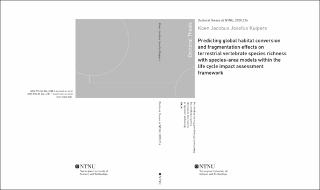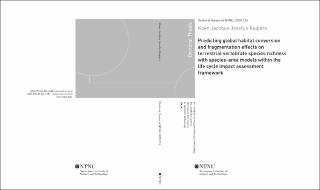| dc.contributor.advisor | Verones, Francesca | |
| dc.contributor.advisor | May, Roel | |
| dc.contributor.advisor | Graae, Bente | |
| dc.contributor.author | Kuipers, Koen Jacobus Josefus | |
| dc.date.accessioned | 2020-07-15T07:49:11Z | |
| dc.date.available | 2020-07-15T07:49:11Z | |
| dc.date.issued | 2020 | |
| dc.identifier.isbn | 978-82-326-4781-1 | |
| dc.identifier.issn | 1503-8181 | |
| dc.identifier.uri | https://hdl.handle.net/11250/2664913 | |
| dc.description.abstract | Habitat change is the single largest threat to global biodiversity. Mainly caused by human land use, this results in the loss and fragmentation of natural habitat and subsequent losses of species. The relevance of halting and reversing biodiversity loss caused by habitat change is recognized by international efforts, such as the Aichi biodiversity targets or the Sustainable Development Goals (SDGs, specifically, SDG 15). A variety of studies and assessments is needed to guide strategies to reach these goals and to assess whether we are on the right track for reaching them. In this light, a quantitative understanding of the effects of human land use is essential.
Environmental decision-support tools can help to channel such information into decision-making processes, thereby helping to guide actions and strategies to minimise biodiversity impacts. Life cycle assessment (LCA) is such a tool that comprehensively assesses impacts along complete value chains. However, currently available life cycle impact assessment (LCIA) models for global land use impacts on species richness consider the effects of habitat conversion only and neglect the additional effects of habitat fragmentation. This means that land use impacts may be systematically underestimated in current LCAs. To more completely capture impacts related to land use, both habitat conversion and fragmentation effects should be considered. This thesis contributes to improving the LCIA characterisation of land use impacts by developing a novel method that considers the combined effects of habitat conversion and fragmentation.
I investigated possible options for including the consideration of fragmentation effects within the LCA framework (Chapter 2). Based on a species-area relationship (SAR) approach, I developed a model that considers the global combined effects of habitat conversion and fragmentation on regional (non-flying) mammal species richness (Chapter 3). Fragmentation effects are estimated from changes in habitat connectivity based on the number and size of habitat patches, permeability of the matrix separating the patches, and species dispersal distances. The results suggest that neglecting fragmentation effects results in an average underestimation of land use impacts of about 10%. This reflects the relevance of considering fragmentation in addition to habitat conversion. In addition to regional species losses, we are interested global species extinctions. Hence, I developed an approach for indicating the potential effect of regional species loss on global species extinctions in a taxon- and regionally-specific manner (Chapter 4). The results highlight focal regions for the conservation of global species richness. A combination of the SAR model including fragmentation and the estimation of the global extinction probabilities results in a novel LCIA land use characterisation method (Chapter 5). This spatially differentiated LCIA model for land use impacts on species richness is globally applicable and considers the combined effects of habitat conversion and fragmentation on amphibians, reptiles, birds and mammals. Overall, these characterisation factors improve the potential for characterizing impacts of land use in LCAs more completely.
The limitations regarding a global approach like the one proposed here is that it generalizes impacts over larger scales, potentially not accurately reflecting local responses to habitat conversion or dispersal behaviour of specific species. Nevertheless, large-scale studies may help to identify global trends or to trace impacts spanning across regions. Hence, LCA biodiversity assessments are best suited for comparative analyses at larger scales. This thesis is an important step forward to more completely cover the aspects of land use impacts on species richness in LCA. | en_US |
| dc.language.iso | eng | en_US |
| dc.publisher | NTNU | en_US |
| dc.relation.ispartofseries | Doctoral theses at NTNU;2020:216 | |
| dc.relation.haspart | Paper 1:
Kuipers, Koen; May, Roelof Frans; Graae, Bente Jessen; Verones, Francesca.
Reviewing the potential for including habitat fragmentation to improve life cycle impact assessments for land use impacts on biodiversity. The International Journal of Life Cycle Assessment 2019 ;Volum 2206.(2219) s. 1-14
https://doi.org/10.1007/s11367-019-01647-1 | |
| dc.relation.haspart | Paper 2:
Kuipers, Koen JJ.; Hilbers,Jelle P.; Garcia-Ulloa, John; Graae,Bente J.; May, Roel; Verones, Francesca; Huijbregts,Mark AJ.; Schipper, Aafke, M.
Global effects of habitat conversion and fragmentation on regional mammal species
richness | |
| dc.relation.haspart | Paper 3:
Kuipers, Koen; Hellweg, Stefanie; Verones, Francesca.
Potential Consequences of Regional Species Loss for Global Species Richness: A Quantitative Approach for Estimating Global Extinction Probabilities. Environmental Science and Technology 2019 ;Volum 53.(9) s. 4728-4738
https://doi.org/10.1021/acs.est.8b06173
Copyright © 2019 American Chemical Society | |
| dc.relation.haspart | Paper 4:
Kuipers, Koen; May, Roel; Verones, Francesca.
Considering habitat conversion and fragmentation in characterisation factors for land use impacts
on vertebrate species richness | |
| dc.title | Predicting global habitat conversion and fragmentation effects on terrestrial vertebrate species richness with species-area models within the life cycle impact assessment framework | en_US |
| dc.type | Doctoral thesis | en_US |
| dc.subject.nsi | VDP::Technology: 500::Environmental engineering: 610 | en_US |
| dc.description.localcode | digital fulltext is not avialable | en_US |

